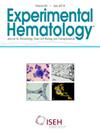ZC3H13 facilitates the progression of acute myeloid leukemia through m6A-FOXP1-mediated metabolic reprogramming
IF 2.1
4区 医学
Q2 HEMATOLOGY
引用次数: 0
Abstract
Acute myeloid leukemia (AML) is a complex hematologic malignancy characterized by rapid progression and high relapse rates. Zinc finger CCCH domain-containing protein 13 (ZC3H13) has been implicated in the pathogenesis of various diseases, but its role in AML remains unclear. This study aimed to elucidate the function and underlying mechanisms of ZC3H13 in AML. Gene expression patterns and correlations with patient survival were analyzed using the Gene Expression Profiling Interactive Analysis (GEPIA) database. ZC3H13 expression was quantified in AML bone marrow samples and cell lines via real-time reverse-transcription PCR (qRT-PCR) and Western blotting. Cell proliferation was assessed using Cell counting kit-8 (CCK-8) and 5-ethynyl-2′-deoxyuridine (EdU) assays, whereas flow cytometry was employed to evaluate cell cycle progression, apoptosis, and reactive oxygen species (ROS) levels. Glycolytic activity—including glucose consumption, lactate production, and ATP levels—was measured using commercial kits. Oxidative stress markers such as superoxide dismutase (SOD), malondialdehyde (MDA), and glutathione (GSH) were also quantified. The LinkedOmics database was used to identify ZC3H13-associated genes and predict their functional correlations. Potential m6A modification sites on FOXP1 mRNA were predicted using the SRAMP tool and validated through methylated RNA immunoprecipitation (MeRIP) assays. A dual-luciferase reporter assay confirmed direct binding of ZC3H13 to the FOXP1 promoter. ZC3H13 was found to be highly expressed in AML bone marrow and cell lines. Functionally, ZC3H13 promoted cell proliferation, enhanced glycolysis, and suppressed both apoptosis and oxidative stress. Mechanistically, ZC3H13 stabilized FOXP1 expression via m6A methylation, thereby contributing to AML progression. In conclusion, ZC3H13 accelerates AML development by modulating the m6A-FOXP1 axis, leading to metabolic reprogramming. These findings provide novel insights into AML pathogenesis and offer potential targets for therapeutic intervention.
ZC3H13通过m6a - foxp1介导的代谢重编程促进急性髓系白血病的进展。
急性髓性白血病(AML)是一种复杂的血液系统恶性肿瘤,其特点是进展迅速,复发率高。锌指CCCH结构域蛋白13 (ZC3H13)参与多种疾病的发病机制,但其在AML中的作用尚不清楚。本研究旨在阐明ZC3H13在AML中的功能和潜在机制。使用GEPIA数据库分析基因表达模式及其与患者生存的相关性。通过qRT-PCR和western blotting检测AML骨髓样品和细胞系中ZC3H13的表达。采用CCK-8和EdU检测细胞增殖,流式细胞术检测细胞周期进展、凋亡和活性氧(ROS)水平。糖酵解活性-包括葡萄糖消耗,乳酸生成和ATP水平-使用商用试剂盒进行测量。氧化应激标志物如SOD、MDA和GSH也被量化。使用LinkedOmics数据库识别zc3h13相关基因并预测其功能相关性。使用SRAMP工具预测FOXP1 mRNA上潜在的m6A修饰位点,并通过MeRIP检测进行验证。双荧光素酶报告试验证实ZC3H13与FOXP1启动子直接结合。发现ZC3H13在AML骨髓和细胞系中高表达。功能上,ZC3H13促进细胞增殖,增强糖酵解,抑制细胞凋亡和氧化应激。从机制上讲,ZC3H13通过m6A甲基化稳定FOXP1表达,从而促进AML进展。总之,ZC3H13通过调节m6A-FOXP1轴加速AML的发展,导致代谢重编程。这些发现为AML的发病机制提供了新的见解,并为治疗干预提供了潜在的靶点。摘要:ZC3H13在AML中高表达,并通过促进糖酵解、抑制细胞凋亡和减少氧化应激来促进白血病进展。从机制上讲,ZC3H13通过m6A甲基化稳定FOXP1表达,驱动代谢重编程。这些发现揭示了一个新的ZC3H13-FOXP1轴,并提示了AML治疗的潜在治疗靶点。
本文章由计算机程序翻译,如有差异,请以英文原文为准。
求助全文
约1分钟内获得全文
求助全文
来源期刊

Experimental hematology
医学-血液学
CiteScore
5.30
自引率
0.00%
发文量
84
审稿时长
58 days
期刊介绍:
Experimental Hematology publishes new findings, methodologies, reviews and perspectives in all areas of hematology and immune cell formation on a monthly basis that may include Special Issues on particular topics of current interest. The overall goal is to report new insights into how normal blood cells are produced, how their production is normally regulated, mechanisms that contribute to hematological diseases and new approaches to their treatment. Specific topics may include relevant developmental and aging processes, stem cell biology, analyses of intrinsic and extrinsic regulatory mechanisms, in vitro behavior of primary cells, clonal tracking, molecular and omics analyses, metabolism, epigenetics, bioengineering approaches, studies in model organisms, novel clinical observations, transplantation biology and new therapeutic avenues.
 求助内容:
求助内容: 应助结果提醒方式:
应助结果提醒方式:


